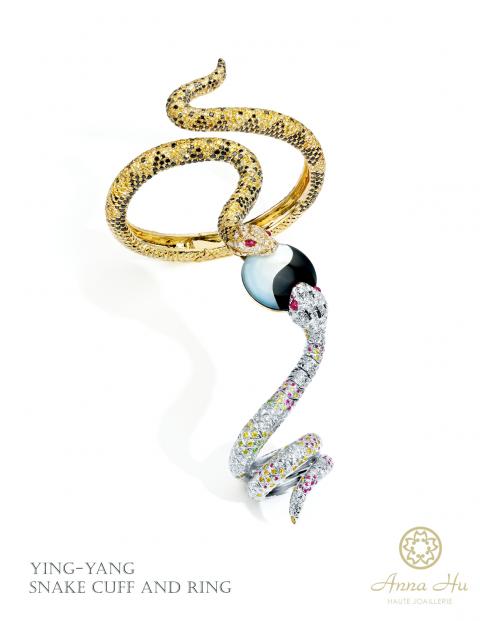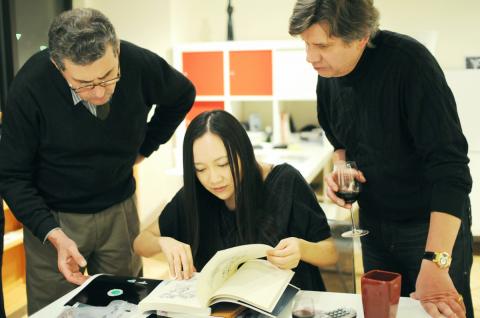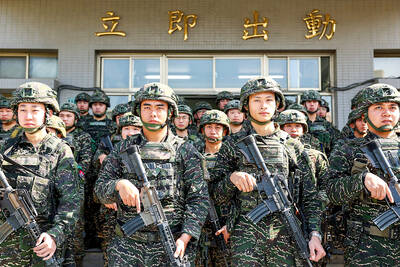Anna Hu (胡茵菲) had her heart set on a career as a cellist until a shoulder injury cut short her musical aspirations. Now the 34-year-old shines as a jeweler whose luxurious, art-inspired designs have attracted clients ranging from Cindy Sherman to Madonna. Her creations also make regular appearances on the red carpet, including February’s Academy Awards, where Scarlett Johansson and Hilary Swank wore pieces that paid homage to Surrealist paintings.
Though she launched New York City-based Anna Hu Haute Joaillerie just four years ago, Hu has already garnered high praise among jewelry connoisseurs and collectors. In a Wall Street Journal profile, David Warren, the director of Christie’s in London and the Middle East, said Hu is considered among the top five or six contemporary jewelry designers in the world.
Born in Taiwan, Hu immigrated to the US with her family when she was a teenager. Though both her parents worked in the jewelry trade, Hu’s first passion was classical music.

Photos courtesy of Anna Hu Haute Joaillerie
“Before I hurt my shoulder, my whole life was about the cello,” says Hu, who practiced at least five hours a day before developing tendinitis. Her chiropractor ordered her to reduce her playing time to half an hour.
With her musical career on hold, Hu felt “very empty.”
“It was in 1997, right around my birthday in March, and for two months it was like hell for me,” she says.

Photo Courtesy of Anna Hu Haute Joaillerie
Then her father, a diamond dealer, suggested that she take a jewelry design class to help lift her out of her depression.
“It was like a transformation for me,” Hu says. “I learned that it doesn’t matter if it’s performing arts or visual arts, it’s all universal.”
Hu, who earned master’s degrees in art history and art administration from the Parsons School of Design and Columbia University, now applies the same perfectionist tendencies to her jewelry that she did to the cello. She cites artists Vincent van Gogh, Gustav Klimt and Chang Dai-chien (張大千) as inspirations; her favorite jeweler is Rene Lalique.

Photo Courtesy of Anna Hu Haute Joaillerie
Despite her celebrity clientele, Hu lays down the law for her custom work and insists on creating pieces that reflect her aesthetic point of view.
“I don’t care if someone is rich or whatever their status is, I don’t give a damn,” Hu says. “They come to me, they listen to me.”
She compares the process of designing a piece of jewelry to composing a symphony.

Photo Courtesy of Anna Hu Haute Joaillerie
“Every gemstone is like a musical note. The contours, the shapes, the lines, are like the melody,” Hu says. “The setting technique, the wax modeling and the construction of the jewelry is really like musical theory, it’s like the rhythm.”
Hu listens to the same pieces of classical music over and over again while working. Johann Sebastian Bach’s concertos are “very symmetrical, very structured, with a lot of symmetry” and inspire her when she creates art deco designs.
Frederic Chopin was her composer of choice while making the bold, lushly detailed jewelry Johansson and Swank wore to the Oscars.
“I related them to Chopin, because they are ultra-romantic and very passionate, with organic curvilinear lines,” Hu says.
Crafted by jewelers in New York City and Paris, Hu’s pieces can take years from conception to the final product. One of Hu’s newest showcase creations, a dramatic collar set with hundreds of precious stones in delicate shades inspired by the artwork of Claude Monet, hails back to a trip Hu made to Giverny, France, when she was 21 years old.
Afterward, she visited the Musee d’Orsay and the Museum of Modern Art in New York City to study Monet’s water lily paintings. While working on the necklace, Hu only listened to works by Impressionist composers Maurice Ravel and Claude Debussy.
The setting of the Monet Water Lily Necklace, which includes various gems in a spectrum of soft, watercolor-like colors offset by glittering diamonds of varying sizes, took more than two years to finish.
Hu began with a sketch before picking different jewels for the piece, treating the precious stones like pigment as she laid them out in a wax model.
When Hu showed the stunningly extravagant final creation to her father, who supplies all her jewels, his jaw dropped.
“We bought all these amazing gemstones and he said, ‘I think you can do about a hundred pieces with them,’” Hu says. “He was expecting a hundred different designs and I put them all into one.”
She has already decided that she will make 999 one-of-a-kind pieces before she retires (the Mandarin pronunciation of nine is a homophone for “longevity”) and organize a solo exhibition of her jewelry every five years. She figures that her plan will keep her busy until she is 75 years old.
“It’s all connected, from music to painting to jewelry. It makes sense to me,” Hu says. “I just feel like I am in another world.”
For more information: www.anna-hu.com

That US assistance was a model for Taiwan’s spectacular development success was early recognized by policymakers and analysts. In a report to the US Congress for the fiscal year 1962, former President John F. Kennedy noted Taiwan’s “rapid economic growth,” was “producing a substantial net gain in living.” Kennedy had a stake in Taiwan’s achievements and the US’ official development assistance (ODA) in general: In September 1961, his entreaty to make the 1960s a “decade of development,” and an accompanying proposal for dedicated legislation to this end, had been formalized by congressional passage of the Foreign Assistance Act. Two

Despite the intense sunshine, we were hardly breaking a sweat as we cruised along the flat, dedicated bike lane, well protected from the heat by a canopy of trees. The electric assist on the bikes likely made a difference, too. Far removed from the bustle and noise of the Taichung traffic, we admired the serene rural scenery, making our way over rivers, alongside rice paddies and through pear orchards. Our route for the day covered two bike paths that connect in Fengyuan District (豐原) and are best done together. The Hou-Feng Bike Path (后豐鐵馬道) runs southward from Houli District (后里) while the

President William Lai’s (賴清德) March 13 national security speech marked a turning point. He signaled that the government was finally getting serious about a whole-of-society approach to defending the nation. The presidential office summarized his speech succinctly: “President Lai introduced 17 major strategies to respond to five major national security and united front threats Taiwan now faces: China’s threat to national sovereignty, its threats from infiltration and espionage activities targeting Taiwan’s military, its threats aimed at obscuring the national identity of the people of Taiwan, its threats from united front infiltration into Taiwanese society through cross-strait exchanges, and its threats from

March 31 to April 6 On May 13, 1950, National Taiwan University Hospital otolaryngologist Su You-peng (蘇友鵬) was summoned to the director’s office. He thought someone had complained about him practicing the violin at night, but when he entered the room, he knew something was terribly wrong. He saw several burly men who appeared to be government secret agents, and three other resident doctors: internist Hsu Chiang (許強), dermatologist Hu Pao-chen (胡寶珍) and ophthalmologist Hu Hsin-lin (胡鑫麟). They were handcuffed, herded onto two jeeps and taken to the Secrecy Bureau (保密局) for questioning. Su was still in his doctor’s robes at